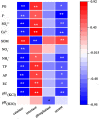Effects of phosphogypsum on enzyme activity and microbial community in acid soil
- PMID: 37062764
- PMCID: PMC10106453
- DOI: 10.1038/s41598-023-33191-2
Effects of phosphogypsum on enzyme activity and microbial community in acid soil
Abstract
Phosphogypsum (PG) is a solid waste produced from decomposition of phosphate rock in sulfuric acid. It can improve the physicochemical properties of soil. However, the application of PG will inevitably change the living environment of soil microorganisms and lead to the evolution of the soil microbial community. The effects of PG (0, 0.01%, 0.1%, 1%, 10% PG) on soil respiration, enzyme activity and microbial community were studied systematically by indoor incubation experiments. The results showed that the addition of 0.01% PG had little effect on the soil physicochemical properties and microflora. The soil respiration rate decreased with the increase of PG; The activities of catalase, urease and phosphatase were decreased and the activities of sucrase were increased by 10% PG treatment, while 0.01% or 0.1% PG treatment improve the urease activity; Soil microbial community response was significantly separated by amount of the PG amendment, and the application of 10% PG reduced the abundance, diversity and evenness of soil bacteria and fungi. Redundancy analysis (RDA) showed that soil bacterial composition was mainly driven by electrical conductivity (EC) and Ca2+, while fungal composition was mainly driven by F- and NH4+. In addition, the application of PG increased the abundance of salt-tolerant microorganisms and accelerated the degradation of soil organic matter. Overall, These results can help to revisit the current management of PG applications as soil amendments.
© 2023. The Author(s).
Conflict of interest statement
The authors declare no competing interests.
Figures






Similar articles
-
[Potential of Arbuscular Mycorrhizal Fungi, Biochar, and Combined Amendment on Sandy Soil Improvement Driven by Microbial Community].Huan Jing Ke Xue. 2021 Apr 8;42(4):2066-2079. doi: 10.13227/j.hjkx.202008154. Huan Jing Ke Xue. 2021. PMID: 33742842 Chinese.
-
Response of enzyme activities and microbial communities to soil amendment with sugar alcohols.Microbiologyopen. 2016 Aug;5(4):604-15. doi: 10.1002/mbo3.355. Epub 2016 Mar 23. Microbiologyopen. 2016. PMID: 27005019 Free PMC article.
-
Biochar decreased microbial metabolic quotient and shifted community composition four years after a single incorporation in a slightly acid rice paddy from southwest China.Sci Total Environ. 2016 Nov 15;571:206-17. doi: 10.1016/j.scitotenv.2016.07.135. Epub 2016 Jul 27. Sci Total Environ. 2016. PMID: 27471985
-
Effect of fungicides on soil respiration, microbial community, and enzyme activity: A global meta-analysis (1975-2024).Ecotoxicol Environ Saf. 2025 Jan 1;289:117433. doi: 10.1016/j.ecoenv.2024.117433. Epub 2024 Dec 4. Ecotoxicol Environ Saf. 2025. PMID: 39637631 Review.
-
Advances in Phosphogypsum Calcination and Decomposition Processes in Circulating Fluidized Beds.ACS Omega. 2024 Sep 11;9(38):39307-39325. doi: 10.1021/acsomega.4c05475. eCollection 2024 Sep 24. ACS Omega. 2024. PMID: 39346888 Free PMC article. Review.
Cited by
-
Effect of different fertilization strategies on the yield, quality of Euryales Semen and soil microbial community.Front Microbiol. 2023 Nov 30;14:1310366. doi: 10.3389/fmicb.2023.1310366. eCollection 2023. Front Microbiol. 2023. PMID: 38098669 Free PMC article.
-
Phosphogypsum with Rice Cultivation Driven Saline-Alkali Soil Remediation Alters the Microbial Community Structure.Plants (Basel). 2024 Oct 8;13(19):2818. doi: 10.3390/plants13192818. Plants (Basel). 2024. PMID: 39409688 Free PMC article.
-
Analysis of microbial communities in solid and liquid pig manure during the fertilization process.Sci Rep. 2024 Jan 2;14(1):72. doi: 10.1038/s41598-023-50649-5. Sci Rep. 2024. PMID: 38168767 Free PMC article.
References
-
- Wu F, et al. Highly targeted solidification behavior of hazardous components in phosphogypsum. Chem. Eng. J. Adv. 2022;9:100227. doi: 10.1016/j.ceja.2021.100227. - DOI
-
- He H, Hao L, Fan C, Li S, Lin W. A two-step approach to phosphogypsum decomposition: oxidation of CaS with CO2. Thermochim. Acta. 2022;708:179122. doi: 10.1016/j.tca.2021.179122. - DOI
-
- Cao W, Yi W, Peng J, Li G, Yin S. Preparation of anhydrite from phosphogypsum: Influence of phosphorus and fluorine impurities on the performances. Constr. Build. Mater. 2022;318:126021. doi: 10.1016/j.conbuildmat.2021.126021. - DOI
-
- Cuadri AA, Pérez-Moreno S, Altamar CL, Navarro FJ, Bolívar JP. Phosphogypsum as additive for foamed bitumen manufacturing used in asphalt paving. J. Clean. Prod. 2020;283:124661. doi: 10.1016/j.jclepro.2020.124661. - DOI
-
- Modolon V, Jos F, Eduardo F. Does direct-seeded rice performance improve upon lime and phosphogypsum use? Soil Tillage Res. 2021;212:105055. doi: 10.1016/j.still.2021.105055. - DOI
Publication types
MeSH terms
Substances
LinkOut - more resources
Full Text Sources
Miscellaneous

